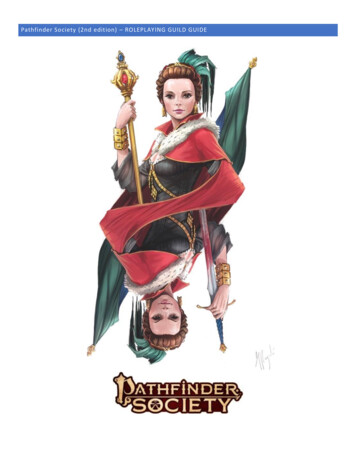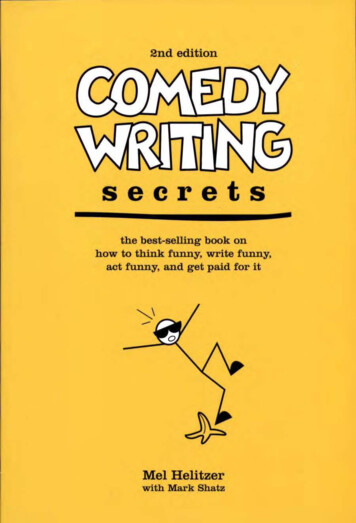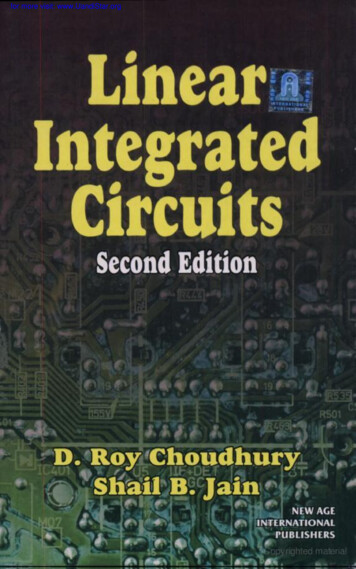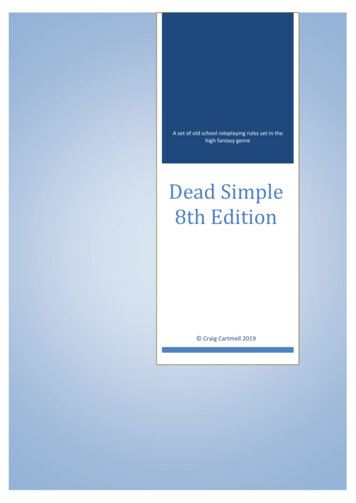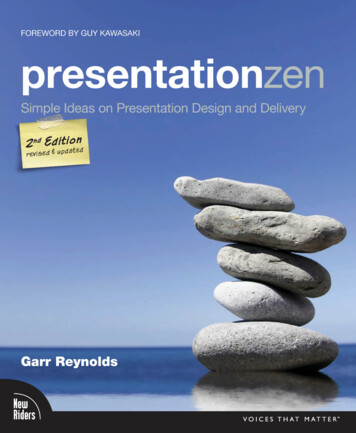
Transcription
for Presentation Zen: Simple Ideas on Presentation Design andDelivery, Second Edition Praise“ It's often the slim books that have the most impact. Strunk and White for proper English.Robert’s Rules of Order for running meetings. Both deceptively short, with huge impact. Tothese I find it easy to add Presentation Zen for moving an audience. Embrace this wonderfulguide and gain the power of crafting simple and clear messages. Garr Reynolds providestechniques and examples in a manner that, quite naturally, adheres to the same principlesas what he teaches.”—Ric Bretschneider, Senior Program Manager,PowerPoint Development Team 1993-2010“ Garr is a beacon of hope for frustrated audiences everywhere. His design philosophy andfundamental principles bring life to messages and can invigorate careers. His principles ofsimplicity are as much a journey of the soul as they are restraint of the mouse.”—Nancy Duarte, CEO, Duarte, Inc., andauthor of slide:ology and resonate“ Presentation Zen changed my life and the lives of my clients. As a communications specialist,I was searching for a way to create visuals that support the narrative without detracting fromthe story. The philosophy and approach so elegantly explained in Garr's book will inspire youraudience. Don't even think of giving another presentation without it!”—Carmine Gallo, author of The PresentationSecrets of Steve Jobs“ Garr has broken new ground in the way we think about the power of presentations, and moreimportant, has taught an entire generation of communicators how to do a better job. Don’tmiss this one.”—Seth Godin, legendary presenterand author of We Are All Weird“ If you care about the quality and clarity of your presentations—and you should—pick up thisbook, read every page, and heed its wisdom. Presentation Zen is a contemporary classic.”—Daniel H. Pink, author ofDrive and A Whole New Mind“ Four years ago, Garr’s Presentation Zen literally changed the world of communications. Almostovernight, what was once fluffy, stale, and boring became sharp, brisk, and even (can we sayit?) fun. A million radically-improved speeches later, the world is ready for a refresher—andjust when we need it most, Garr delivers the magic again.”—Dan Roam, author of Blah-Blah-Blahand The Back of the Napkin
This page intentionally left blank
presentation zenSimple Ideas on Presentation Design and Deliverydn2n Edupitdiotea drevised &Garr Reynolds
Presentation Zen: Simple Ideas on Presentation Design and DeliverySecond EditionGarr ReynoldsNew Riders1249 Eighth StreetBerkeley, CA 94710510/524-2178510/524-2221 (fax)Find us on the Web at: www.newriders.comTo report errors, please send a note to errata@peachpit.comNew Riders is an imprint of Peachpit, a division of Pearson EducationCopyright 2012 by Garr ReynoldsSenior Editor: Karyn JohnsonCopy Editor: Kelly Kordes AntonProduction Editor: Cory BormanProofreader: Roxanna AliagaIndexer: Emily GlossbrennerDesign Consultant in Japan: Mayumi NakamotoBook Cover and Interior Design: Garr ReynoldsNotice of RightsAll rights reserved. No part of this book may be reproduced or transmitted in any form by any means,electronic, mechanical, photocopying, recording, or otherwise, without the prior written permission ofthe publisher. For information on getting permission for reprints and excerpts, contact permissions@peachpit.com.Notice of LiabilityThe information in this book is distributed on an “As Is” basis without warranty. While every precautionhas been taken in the preparation of the book, neither the author nor Peachpit shall have any liabilityto any person or entity with respect to any loss or damage caused or alleged to be caused directly orindirectly by the instructions contained in this book or by the computer software and hardware productsdescribed in it.TrademarksMany of the designations used by manufacturers and sellers to distinguish their products are claimedas trademarks. Where those designations appear in this book, and Peachpit was aware of a trademarkclaim, the designations appear as requested by the owner of the trademark. All other product names andservices identified throughout this book are used in editorial fashion only and for the benefit of suchcompanies with no intention of infringement of the trademark. No such use, or the use of any tradename, is intended to convey endorsement or other affiliation with this book.ISBN-13: nted and bound in the United States of America
To Mom & Dad
Table of ContentsAcknowledgments, ixForeword by Guy Kawasaki, xINTRODUCTIONPresenting in Today’s World, 5PREPARATIONCreativity, Limitations, and Constraints, 31Planning Analog, 45Crafting the Story, 77DESIGNSimplicity: Why It Matters, 115Presentation Design: Principles and Techniques, 131Sample Visuals: Images & Text, 187DELIVERYThe Art of Being Completely Present, 215Connecting with an Audience, 231The Need for Engagement, 253NEXT STEPThe Journey Begins, 285Photo Credits, 292Index, 294
viii
AcknowledgmentsThis book would not have been possible withouta lot of help and support. I’d like to thank thefollowing people for their contributions andencouragement:Nancy Duarte and Mark Duarte and all theamazing staff at Duarte, Inc. in Silicon Valley,including Nicole Reginelli and Paula Tesch fortheir constant support.At New Riders: Michael Nolan who asked meto write this book originally and Karyn Johnsonwho oversaw the book development this timearound and gave me the freedom to do it myway (yeah, like the song). Kelly Kordes Antonand Roxanna Aliaga, for bringing more clarity tomy writing and uncovering errors and offeringadvice for improvement. Mimi Heft for herhelp with the design and the cover. Hilal Sala,for her great help and guidance in the firstedition, and to Cory Borman, for his talent andguidance in production on this edition.Guy Kawasaki, Seth Godin, David S. Rose,Daniel Pink, Dan Heath and Rick Heath,Rosamund Zander, Jim Quirk, and Deryn Verityfor their enlightened advice and content in theearly stages of the process.Jumpei Matsuoka and all the cool people atiStockphoto.com for their tremendous supportwith the images and the special offer that’sincluded at the back of this book.Designer Mayumi Nakamoto for teachingme more than I wanted to know (or thoughtpossible) about Adobe InDesign. June Cohenand Michael Glass at TED for their help withthe images. Daniel Lee at Mojo for his helpwith the credits. Aaron Walker, Tom Grant’sproducer in Japan, for his great assistance.The Design Matters Japan communityincluding Toru Yamada, Shigeki Yamamoto,Tom Perry, Darren Saunders, Daniel Rodriguez,Kjeld Duits, David Baldwin, Nathan Bryan,Jiri Mestecky, Doug Schafer, Barry Louie, andmany, many others.Back in the States, a big thank you to thosewho contributed ideas and support, includingDebbie Thorn, CZ Robertson, David Roemer,Gail Murphy, Ric Bretschneider, HowardCooperstein, Dan Roam and Carmine Gallo.And thanks to Mark and Liz Reynolds for theirfantastic B&B at the beach.I’d like to thank the thousands of subscribersto the Presentation Zen blog and to all the blogreaders who have contacted me over the yearsto share their stories and examples, especiallyLes Posen in Australia.Although I could not include all the slidesin this book, I want to thank all the peoplewho submitted sample slides, including: JeffBrenman, Chris Landry, Scott B. Schwertly, JillCadarette, Kelli Matthews, Luis Iturriaga, Dr.Aisyah Saad Abdul Rahim, Marty Neumeier,Markuz Wernli Saito, Sangeeta Kumar, AllyssonLucca, Pam Slim, Jed Schmidt, Merlin Mann,and many others. Also, a big thank you toDr. Andreas Eenfeldt in Stockholm and PhilWaknell and Pierre Morsa in Paris.And, of course, my biggest supporter inall this was my wife, Ai, who was alwaysunderstanding and a great source of inspirationand ideas (and occasionally, chocolate-chipcookies).ix
Foreword by Guy KawasakiBecause this is a book about presenting better with slides,I thought it would be appropriate to show the forewordas a slide presentation. As far as I know, this is the firstforeword in history presented in a book as a series ofpresentation slides. Now, good slides should enhance a livetalk; slides are not meant to tell the whole story withoutyou there. But from the slides on the next page, I thinkyou can get my point. If I were to give a live talk about whyyou should buy this book, the slides would look somethinglike this.Guy KawasakiAuthor of Enchantment: The Art ofChanging Hearts, Minds, and Actions,and former chief evangelist of Applewww.guykawasaki.comx
xi
Crafting the Story4During your time off the grid, you brainstormed alone or perhaps with a smallgroup of people. You stepped back to get the big picture, and you identifiedyour core message. You now have a clearer picture of the presentation contentand focus even if you do not have all the details worked out yet. The next stepis to give your core message and supporting messages a logical structure.Structure will help bring order to your presentation and make it easier for youto deliver it smoothly and for your audience to understand your message easily.Before you go from analog to digital—taking your ideas from sketches onpaper and laying them out in PowerPoint or Keynote—it is important to keepin mind what makes your ideas resonate with people. What makes somepresentations absolutely brilliant and others forgettable? If your goal is tocreate a presentation that is memorable, then you need to consider how youcan craft messages that stick.One of the components for creating sticking messages is story. We tellstories all the time. Think about times you may have been camping with agroup of people, taking a tiny step back to a more primitive time, where theevening develops into long sessions of storytelling around the campfire. Thereis something very natural, compelling, and memorable about both telling andlistening to stories.Chapter 4 Crafting the Story77
What Makes Messages Stick?Most of the great books that will help you make better presentations are notspecifically about presentations at all, and they are certainly not about how touse slideware. One such book is Made to Stick (Random House) by Chip andDan Heath. The Heath brothers were interested in what makes some ideaseffective and memorable and others utterly forgettable. Some stick, and othersfade away. Why? What the authors found—and explain simply and brilliantlyin their book—is that “sticky” ideas have six key principles in common:simplicity, unexpectedness, concreteness, credibility, emotions, and stories.And yes, these six compress nicely into the acronym SUCCESs.The six principles are relatively easy to incorporate into messages—includingpresentations and keynote addresses—but most people fail to use them. Why?The authors say the biggest reason most people fail to craft effective or “sticky”messages is because of what they call the “Curse of Knowledge.” The Curseof Knowledge is essentially the condition whereby the deliverer of the messagecannot imagine what it’s like not to possess his level of background knowledgeon the topic. When he speaks in abstractions to the audience, it makes perfectsense to him but him alone. In his mind, it seems simple and obvious. Thesix principles—SUCCESs—are your weapons, then, to fight your own Curse ofKnowledge (we all have it).Here’s an example the authors used early in their book to explain thedifference between a good, sticky message and a weak garden-variety message.Look at these two messages, which address the same idea. One of them shouldseem very familiar to you.“Our mission is to become the international leader in the spaceindustry through maximum team-centered innovation andstrategically targeted aerospace initiatives.”Or“ put a man on the moon and return him safely by the end of the decade.”78Presentation Zen
The first message sounds similar to CEO-speak today and is barelycomprehensible, let alone memorable. The second message—which is actuallyfrom a 1961 speech by John F. Kennedy—has every element of SUCCESs,and it motivated a nation toward a specific goal that changed the world. JFK,or at least his speechwriters, knew that abstractions are not memorable, nordo they motivate. Yet how many speeches by CEOs and other leaders containphrases such as “maximize shareholder value yada, yada, yada?” Here’s aquick summary of the six principles from Made to Stick that you should keepin mind when crystallizing your ideas and crafting your message for speeches,presentations, or any other form of communication. Simplicity. If everything is important, then nothing is important. Ifeverything is a priority, then nothing is a priority. You must be ruthlessin your efforts to simplify—not dumb down—your message to itsabsolute core. We’re not talking about stupid sound bites here. Everyidea can be reduced to its essential meaning if you work hard enough.For your presentation, what’s the key point? What’s the core? Why does(or should) it matter? Unexpectedness. You can get people’s interest by violating theirexpectations. Surprise people. Surprise will get their interest. But tosustain their interest, you have to stimulate their curiosity. The best wayto do that is to pose questions or open holes in people’s knowledge andthen fill those holes. Make the audience aware that they have a gap intheir knowledge and then fill that gap with the answers to the puzzle (orguide them to the answers). Take people on a journey. Concreteness. Use natural speech and give real examples with realthings, not abstractions. Speak of concrete images, not of vaguenotions. Proverbs are good, say the Heath brothers, at reducing abstractconcepts to concrete, simple, but powerful (and memorable) language.For example, the expression iiseki ni cho or “kill two birds with onestone” is easier than saying something like “let’s work toward maximizingour productivity by increasing efficiency across many departments.”And the phrase “go to the moon and back” by JFK (and Ralph Kramdenbefore him)? Now that’s concrete. You can visualize that.Chapter 4 Crafting the Story79
Credibility. If you are famous in your field, you may have built-incredibility (but even that does not go as far as it used to). Most of us,however, do not have that kind of credibility, so we reach for numbersand cold, hard data to support our claims as market leaders and so on.Statistics, say the Heath brothers, are not inherently helpful. What’simportant is the context and the meaning. Put it in terms people canvisualize. “Five hours of battery life” or “Enough battery life to watchyour favorite TV shows nonstop on your iPod during your next flightfrom San Francisco to New York”? There are many ways to establishcredibility—a quote from a client or the press may help, for example.But a long-winded account of your company’s history will just bore youraudience. E motions. People are emotional beings. It is not enough to take peoplethrough a laundry list of talking points and information on your slides;you must make them feel something. There are a million ways to helppeople feel something about your content. Images are one way tohave audiences not only understand your point better but also have amore visceral and emotional connection to your idea. Explaining thedevastation of the Katrina hurricane and floods in the United States, forexample, could be done with bullet points, data, and talking points. Butimages of the aftermath and the pictures of the human suffering thatoccurred tell the story in ways words, text, and data alone never could.Just the words “Hurricane Katrina” conjure vivid images in your mind.Humans make emotional connections with people, not abstractions.When possible, put your ideas in humanterms. “100 grams of fat” may seem concreteto you, but for others it is an abstraction.A picture of an enormous plate of greasyFrench fries, two cheeseburgers, and a largechocolate shake will hit people at a morevisceral level. “So that’s what 100 grams offat looks like!”80Presentation Zen
Stories. We tell stories all day long. It’s how humans have alwayscommunicated. We tell stories with our words and even with our artand music. We express ourselves through the stories we share. Weteach, we learn, and we grow through stories. In Japan, it is a customfor a senior worker (sempai ) to mentor a younger worker (kohai ) onvarious issues concerning company history and culture and how todo the job. The sempai does much of his informal teaching throughstorytelling although nobody calls it that. Once a younger workerhears the story of what happened to the poor guy who didn’t wear hishardhat on the factory floor, he never forgets the lesson (and he neverforgets to wear his hardhat). Stories get our attention and are easierto remember than lists of rules. People love Hollywood, Bollywood,and indie films. People are attracted to “story.” Why is it, though,that when the majority of smart, talented, story-loving people havethe chance to present, they usually resort to generating streams ofvaguely connected information rather than stories or examples andillustrations? Great ideas and presentations have an element of storyto them.I’ve used these slides in live talkswhile reviewing the key ideas foundin Made to Stick by Chip and DanHeath. (All images on this page andopposite page from iStockphoto.com.)Chapter 4 Crafting the Story81
I believe this nation should commititself to achieving the goal, before thisdecade is out, of landing a man onthe Moon and returning him safely tothe Earth.— John F. KennedyMay 25, 1961
Chapter 4 Crafting the Story83
Story and StorytellingBefore there was the written word, humans used stories to transfer culturefrom one generation to the next. Stories are who we are, and we are our stories.Stories may contain analogies or metaphors, powerful tools for bringing peoplein and helping them understand our thoughts clearly and concretely. The bestpresenters illustrate their points with stories, often personal ones. The easiestway to explain complicated ideas is through examples or by sharing a story thatunderscores the point. If you want your audience to remember your content,then find a way to make it more relevant and memorable by strengthening yourcore message with good, short, stories or examples.Good stories have interesting, clear beginnings; provocative, engagingcontent in the middle; and a clear conclusion. I am not talking about fictionhere. I am talking about reality, regardless of the topic. Remember thatdocumentary films, for example, “tell the story” of whatever it is they arereporting on. Documentaries do not simply tell facts; rather, they engage uswith the story of war, scientific discovery, a dramatic sea rescue, climatechange, and so on. We are wired to forget what our brains perceive asunimportant to our survival. Our conscious mind tells us to read the physicalchemistry book over and over because we need to pass the class, but our brainkeeps telling us this is dull, uninteresting, and unimportant to our survival.The brain cares about story.The Power of StoryStory is an important way to engage the audience and appeal to people’s needfor logic and structure in addition to emotion. Humans are predisposed toremembering experiences in the narrative form; we learn best with a narrativestructure. Humans have been sharing information aurally and visually farlonger than we have been getting information by reading lists. A 2003 HarvardBusiness Review article on the power of story says storytelling is the key toleadership and communication in business: “Forget PowerPoint and statistics,to involve people at the deepest level you need to tell stories.”84Presentation Zen
In an interview with the Harvard Business Review, legendary screenwritingcoach Robert McKee suggests a big part of a leader’s job is to motivate peopleto reach certain goals. “To do that she must engage their emotions,” McKeesays, “and the key to their hearts is story.” The most common way to persuadepeople, says McKee, is with conventional rhetoric and an intellectual processthat, in the business world, often consists of a typical PowerPoint presentationin which leaders build their case with statistics and data. But people are notmoved by statistics alone, nor do they always trust your data. “Statistics areused to tell lies.while accounting reports are often BS in a ball gown.” McKeesays rhetoric is problematic because while we are making our case others arearguing with us in their heads using their own statistics and sources. Evenif you do persuade through argument, says McKee, this is not good enoughbecause “people are not inspired to act on reason alone.” The key, then, is toaim to unite an idea with an emotion, which is best done through story. “Ina story, you not only weave a lot of information into the telling but you alsoarouse your listener’s emotion and energy,” he says.Look for the ConflictA good story is not the beginning-to-end tale of how results meet expectations,McKee says. This is boring. Instead, it’s better to illustrate the “strugglebetween expectation and reality in all its nastiness.” What makes lifeinteresting is “the dark side” and the struggle to overcome the negatives—struggling against negative powers is what forces us to live more deeply, saysMcKee. Overcoming negative powers is interesting, engaging, and memorable.Stories such as this are more convincing.The biggest element a story has, then, is conflict. Conflict is dramatic. Atits core, story is about a conflict between our expectations and cold reality.Story is about an imbalance and opposing forces or a problem that mustbe worked out. A good storyteller describes what it’s like to deal with theseopposing forces such as the difficulty of working with scarce resources, makingdifficult decisions, or undertaking a long journey of scientific discovery, andso on. People prefer to present only the rosy (and boring) picture. “But asa storyteller, you want to position the problems in the foreground and thenshow how you’ve overcome them,” says McKee. If you tell the story of howyou struggled with antagonists, the audience is engaged with you and yourmaterial.Chapter 4 Crafting the Story85
Contrasts Are CompellingWhether we are talking about graphic design or the components of a story,the principle of contrast is one of the most fundamental and importantelements to include. Contrast is about differences, and we are hardwired tonotice differences. You can see the principle of contrast everywhere in goodstorytelling, including filmmaking. For example, in Star Wars IV, there isobviously compelling contrast between the good and noble Rebel Allianceand the dark side of the Death Star and the evil empire. Yet great contrastsexist even between main characters in the story who are on the same side.The young, naïve, idealistic Luke Skywalker character contrasts with the old,wise, and realistic Obi-Wan Kenobi. The level-headed, diplomatic, youngPrincess Leia contrasts with the slightly cocky, irreverant, older Han Solo.These characters are compelling to millions of fans because of their inherentcontrasts and the series of negotiations they go through as they deal withtheir differences. Even R2D2 and C3PO are engaging characters, in large partbecause of their strikingly different personalities. In your own presentations,look for contrasts such as before/after, past/future, now/then, problem/solution,strife/peace, growth/decline, pessimism/optimism, and so on. Highlightingcontrasts is a natural way to bring the audience into your story and make yourmessage more memorable.Using Storytelling Principles in PresentationsYou do not always have a lot of time to prepare your presentation or perhaps itis difficult to see what the story is, so here are three simple steps you can useto prepare virtually any presentation relatively quickly.Basic elements to include in your story:1. Identify the problem. (This could be a problem, for example, that yourproduct solves.)2. Identify causes of the problem. (Give actual examples of the conflictsurrounding the problem.)3. Show how and why you solved the problem. (This is where you provideresolution to the conflict.)86Presentation Zen
Essentially, that’s it: Introduce the problem you have (or did have) and howyou will solve it (or did solve it). Give examples that are meaningful andrelevant to your audience. Remember, story is sequential: “This happened,and then this happened, and therefore this happened, and so on.” Takepeople on a journey that introduces conflict and then resolves that conflict. Ifyou can do this, you will be miles ahead of most presenters who simply recalltalking points and broadcast lists of information. Audiences tend to forgetlists and bullet points, but stories come naturally to us; it’s how we’ve alwaysattempted to understand and remember the bits and pieces of experience.Robert McKee’s point is that you should not fight your natural inclination toframe experiences into a story; instead, embrace this and tell the story of yourexperience of the topic to your audience.Stories and EmotionsOur brains tend to recall experiences or stories that have a strong emotionalelement to them. The emotional components of stories are what helpsthem be remembered. Earlier this year, four students in my Japanese labormanagement class did a presentation on employment security in Japan. Threedays later, when I asked other students to recall the most salient points ofthe presentation, what they remembered most vividly were not the labor laws,the principles, and the changes in the labor market in Japan but, rather, thetopic of karoshi, or suicide related to work, and the issue of suicides in Japan,topics that were quite minor points in the hour-long presentation. Perhaps fiveminutes out of the hour were spent on the issue of karoshi, but that’s what theaudience remembered most. It’s easy to understand why. The issue of deathfrom overworking and the relatively high number of suicides are extremelyemotional topics that are not often discussed. The presenters cited actualcases and told stories of people who died as a result of karoshi. The storiesand the connections they made with the audience caused these relativelysmall points to be remembered because emotions such as surprise, sympathy,and empathy were all triggered.Chapter 4 Crafting the Story87
Kamishibai: Lessons in VisualStorytelling from JapanKamishibai is a form of visual and participatorystorytelling that combines the use of hand-drawnvisuals with the engaging narration of a live presenter.Kami ( 紙 ) means “paper” and shibai ( 芝居 ) means“play/drama.” The origins of kamishibai can be tracedback to various picture storytelling traditions inJapan, which include etoki and emaki scrolls and otherforms of visual storytelling dating back centuries.However, the form of kamishibai that one thinks oftoday developed around 1929 and was popular in the1930s, and ’40s, all but dying out with the introductionof television later in the 1950s. Typical kamishibai consisted of a presenter who stoodto the right of a small wooden box or stage that held the 12–20 cards featuringthe visuals that accompanied each story. This miniature stage was attached to thestoryteller’s bicycle, from which he sold candy to the small children who gatheredbefore the show (this was originally how the storyteller could make a little money).The presenter changed the cards by hand, varying the speed of the transition to matchthe flow of the story he was telling. The best kamishibai presenters did not read thestory, but instead kept their eyes on the audience and occasionally on the current cardin the frame.Kamishibai is as different from picture books as modern presentation visuals aredifferent from documents. In the case of a picture book, there can be more visualdetails and text. However, picture books are usually read alone unlike kamishibai whichis designed to be presented in front of a larger group gathered around the presenterand his visuals.Although kamishibai is a form of visual storytelling that became popular more thaneighty years ago, the lessons from this craft can be applied to modern multimediapresentations. Tara McGowan, who wrote The Kamishibai Classroom (LibrariesUnlimited), says that kamishibai visuals are more like the frames in a movie. “Kamishibaipictures are designed to be seen only for a few [moments], so extraneous detailsdetract from the story and open up the possibilities of misinterpretation.” It'simportant to design each card, she says, “.to focus the audience’s attention oncharacters and scenery that are most important at any given moment. If clarityand economy of expression are the goals, it would be hard to find a more perfectmedium.” It’s easy to imagine how we can apply the same spirit of kamishibai to ourmodern-day presentations that include the use of multimedia and a screen. Here arefive tips from kamishibai that we can apply to our presentations today:1. Visuals should be big, bold, clear, and easy to see.2. Allow graphic elements to fill the frame and bleed off the edges.3. Use visuals in an active way, not a decorative one.4. Aim to carefully trim back the details.5. Make your presentation—visuals and narration—participatory.Photo on this page: Aki Sato, Creative CommonsPhoto on opposite page: Horace Bristol/CORBIS
Stories and AuthenticityI have seen pretty good (though not great) presentations with average deliveryand graphics that were relatively effective because the speaker told relevantstories in a clear, concise manner to support his points in a voice that washuman, not formal. Rambling streams of consciousness will not get it done;audiences need to hear (and see) your points illustrated in real language.Earlier this year, in fact, I saw a fantastic presentation by the CEO of oneof the most famous foreign companies in Japan. The CEO’s PowerPoint
presentation slides. Now, good slides should enhance a live talk; slides are not meant to tell the whole story without you there. But from the slides on the next page, I think you can get my point. If I were to give a live talk about why you should buy this book, the slides would look somethi


